As per our usual practice, we gave a call to Works Performance. Oddly enough, they had not done a shock for the 230 yet. Lots of 90s, 125s and such; no 230s.
Works makes three kinds of shocks for this line of bikes: The first one has adjustable preload (via a threaded shock body). Compression and rebound damping are set at the factory. The next shock has a remote reservoir, but the damping is set at the factory like the low cost spread. The last one, and the one we opted for, is the Pro series shock. It not only has a remote reservoir and preload adjustments, you can also change the compression and rebound externally. For the rider on a tight budget, the $319 shock is the way to go.
Retail price for the Gasser Emulsion is $319.00 each.
Retail price for the Gasser Remote Reservoir is $419.00 each.
Retail price for the Pro Series 3-Way Adjustable is $589.00 each.
All the Works shocks are either gas/oil emulsion design - or oil with remote reservoir, or piggyback reservoirs with a floating piston and nitrogen gas charge. Gas charged shocks offer the benefit of much more consistent compression and rebound than non-gas charged shocks, much longer life for the oil, because nitrogen displaces oxygen, which prevents the oil from burning and breaking down, and since it’s under pressure, it offers higher operating temperature before the oil boils.
Reservoir vs Non-reservoir shocks
The shock is exactly the same in valving, travel, and spring set for your application. The only design difference is that the non-reservoir design mixes the nitrogen and oil together, as opposed to the reservoir design, which keeps the oil and gas separate. An additional benefit of a reservoir design is the greater oil capacity, which takes longer to heat. The heat from the oil radiates through the hose and reservoir, allowing greater surface area for cooling.
Each Works shock is custom made for the weight of the rider, the intended use of the bike and the skill level of the rider. You include this information when ordering the shock. The Gasser series of shock are offered in several stages of tune for the TTR230. Special springing and valving setups are available for riders from 100 to 240 pounds. It’s also made for motocross, trail riding, or cross-country racing. Again, you must tell Works what kind of riding you plan to do, so they can dial the shock in for you.
If you get a Works shock and it isn’t quite right for you, just send the unit back to Works and they’ll dial it in. You have a 30-day ride quality guarantee. Works will re-valve or re-spring the shock at no cost to the customer (except for shipping) and then the 30-day guarantee starts over. Good deal.
Pro Series
Our Pro Series shock featured a through-the-shaft external rebound adjustment. A range of 18 positions is available at the lower end of the shock. On the reservoir, there are 21 clicks of compression adjustment available to dial your ride in to your satisfaction. Add to that that adjustable threaded pre-load, and you can do just about anything with the Pro Series
shock.
Installation
Our installation was straight-forward, but it took quite a while to figure out where to put the remote reservoir. At first, we put the shock in with the hose pointing to the rear. Wrong. The hose hit the air-box like this. After turning the shock around, it was head-scratching time for the reservoir mounting. Eventually we mounted it near the carb on the shift side, with the hose making a loop near the countershaft sprocket (see photos) and put a zip tie on a small bolt to keep the hose tucked in and not flopping around.
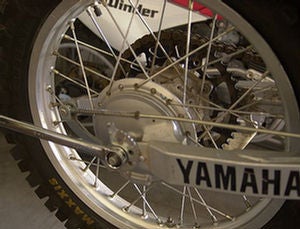 |
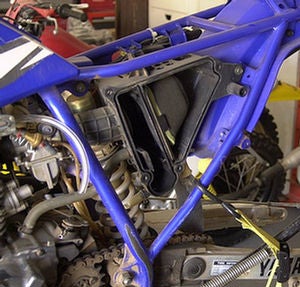 |
| Remove the rear wheel first. | The airbox must be removed to get to the shock. |
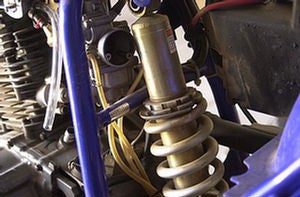 |
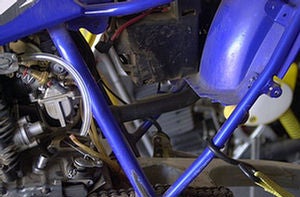 |
| Shock removal is straight-forward and nothing is in the way. | Empty space waiting for a new shock. |
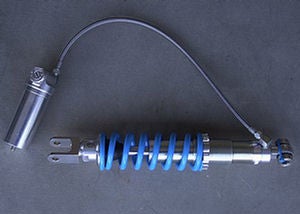 |
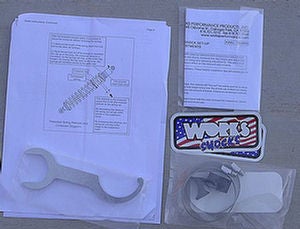 |
| Works Performance gets the nod. | You get all this with a Works shock. |
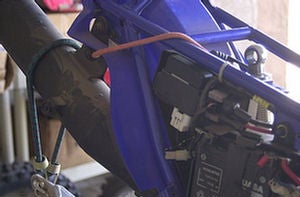 |
|
| Hooking a pair of bungee cords to the shock and the swingarm makes installation easier. | We turned the shock around so resevoir hose would clear the airbox. |
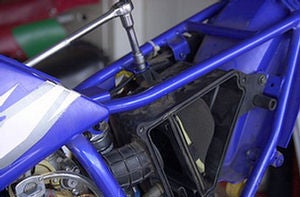 |
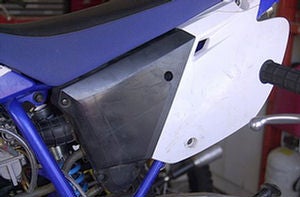 |
| The airbox can now be re-installed. | Airbox cover and sideplate re-installed. |
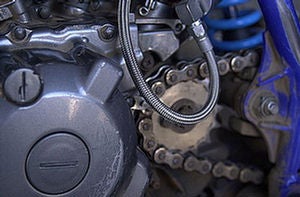 |
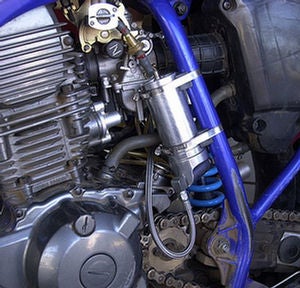 |
| We chose to mount the hose and resevoir next to the front sprocket. | Resevoir was hose clamped in place next to the carb. |
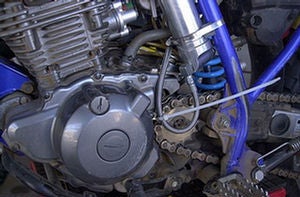 |
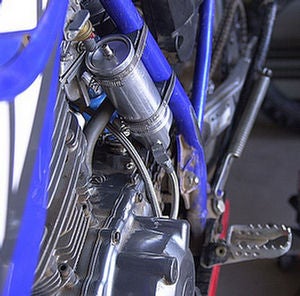 |
| An old vent hose guide was put on a small bolt and zip-tie attached to the hose. | Hose is tucked in nicely and still clears the chain. |
| With good suspension on both ends, the TTR230 has a whole new personality. | |
How she Rides
Out first ride with the new shock was a revelation! The rear end was plush and smooth, with no adjustments needed to the compression or rebound clickers. Even the pre-load felt right. This is because the Works people take into account all the information you give them and pre-set the shock depending on this. So if you’re a Novice rider who trail rides and tell ‘em you’re a fast expert, you might not be happy with the way the shock is delivered. Be honest.With the Works shock and the good forks, the Yamaha TTR230 is now a joy to ride.
Works Performance Products, Inc.
21045 Osborne St.
Canoga Park, CA 91304
(818) 701-1010
Fax (818) 701-9043
www.worksperformance.com


 Your Privacy Choices
Your Privacy Choices